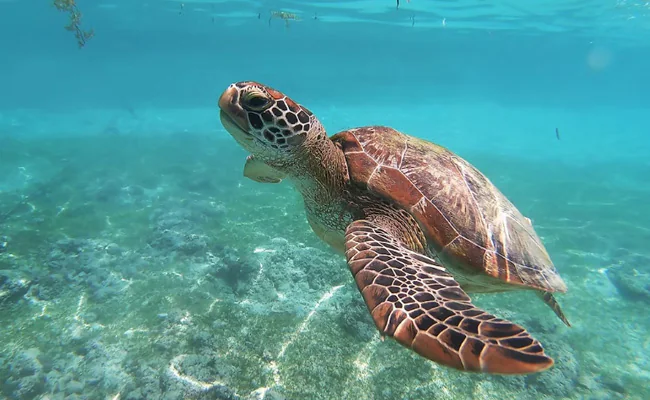Sea Turtle Poaching | 14 Sep 2022
Why in News?
According to a new study, more than 1.1 million sea turtles have been illegally killed and, in some cases, trafficked from 1990 to 2020.
- The sea turtle species that faced the most exploitation in the 30-year-period were Green (56%) and Hawksbill Sea Turtles (39%).
What are the Key Highlights of the Study?
- Marginal Decline in Poaching: There has been a decline of 28% in the poaching of marine creatures, with over 44,000 turtles targeted annually over the last decade.
- Exploitation: The reptiles faced exploitation in 65 countries/territories and 44 marine turtle regional management units (RMU) in the world despite various protection laws.
- Illegal Trade of Species: Southeast Asia and Madagascar were major hotspots for illegal sea turtle trade, particularly for the critically endangered Hawksbills.
- Vietnam was the most common country of origin for illegal sea turtle trafficking, while China and Japan served as destinations for nearly all trafficked sea turtle products.
- They are slaughtered for their eggs, meat, skin, and shell and they also face habitat destruction and accidental capture or bycatch in fishing gear.
- Effects of Climate change: The Climate change has an impact on turtle nesting sites — it alters sand temperatures, which affects the sex of hatchlings.
- Because incubation temperature of turtle eggs determines the animal’s sex, a warmer nest results in more females. Increasing temperatures in Queensland’s north, (Australia), linked to climate change, have led to virtually no male Green Sea turtles being born.
- Initiatives:
- Global: In 2017, residents in eastern Indonesia’s Maluku Province harvested up to 75% of leatherback turtle eggs laid on one turtle nesting beach.
- Education and community outreach done by organisations like the non-governmental organisation World Wide Fund has helped in reducing turtle egg harvesting by 10%.
- Indian: There are plans to tag 30,000 Olive Ridley turtles in Odisha, it will help scientists study them and draft conservation plans.
- Global: In 2017, residents in eastern Indonesia’s Maluku Province harvested up to 75% of leatherback turtle eggs laid on one turtle nesting beach.
What do We Need to Know about Sea Turtles?
- About:
- Sea turtles are marine reptiles with streamlined bodies and large flippers that are well-adapted to life in the ocean.
- The sea turtle family includes the Hawksbill, Loggerhead, Leatherback, Green and Olive ridley turtle.
- These five species are found worldwide, mainly in tropical and subtropical waters.
- Other than the five species, there are two more types of sea turtles that have restricted ranges.
- Kemp’s Ridley is found mainly in the Gulf of Mexico and the Flatback Turtle around northern Australia and southern Papua New Guinea.
- Conservation Status:
- The International Union for Conservation of Nature (IUCN) Status:
- Flatback Turtle: Data Deficient
- Green Turtle: Endangered
- Hawksbill Turtle: Critically Endangered
- Kemp’s Ridley: Critically Endangered
- Loggerhead Turtle: Vulnerable
- Olive Ridley: Vulnerable
- Leatherback Turtle: Vulnerable
- The Convention on International Trade in Endangered Species of Wild Fauna and Flora (CITES) status:
- All seven species of sea turtles are currently listed as Appendix- I under CITES.
- The International Union for Conservation of Nature (IUCN) Status:
UPSC Civil Services Examination Previous Year Question (PYQ)
Prelims
Q. Consider the following statements: (2019)
- Some species of turtles are herbivores.
- Some species of fish are herbivores.
- Some species of marine mammals are herbivores.
- Some species of snakes are viviparous.
Which of the statements given above are correct?
(a) 1 and 3 only
(b) 2, 3 and 4 only
(c) 2 and 4 only
(d) 1, 2, 3 and 4
Ans: (d)
Exp:
- Green sea turtles are adapted to the mostly vegetarian diet of sea grasses and algae. As adults, these are the only predominantly herbivorous sea turtles, although they are carnivorous from hatching until juvenile size. Hence, statement 1 is correct.
- Surgeonfish and parrotfish are two species of fish often seen feeding on reef algae. Hence, statement 2 is correct.
- Manatees, sometimes called sea cows, are large mammals that live in the warm sea waters. They live in shallow coastal areas and feed on sea vegetation. Hence, statement 3 is correct.
- Snakes that are viviparous nourish their young ones through a placenta and yolk sac. Boa constrictors and green anacondas are two examples of viviparous snakes. Hence, statement 4 is correct. Therefore, option (d) is the correct answer

